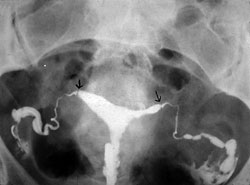
HYSTEROSALPINGOGRAPHY (HSG)
About 15% of women who attend an Infertility Clinic have a problem with their fallopian tubes. Half of these women will have no past medical history to suggest a tubal problem.
One of the important investigations arranged via the Infertility Clinic is a tubal patency test. The “gold standard” is considered to be laparoscopy and dye testing. But this is an invasive procedure as it requires hospital admission, a general anaesthetic and small operation. Laparoscopy is particularly indicated when there is an increased likelihood of finding tubal problems, for example when there has been a past episode of peritonitis from a burst appendix or possible scarring and adhesion formation following previous pelvic surgery.
A Hysterosalpingogram (or HSG) is an X-ray investigation of the uterus and tubes. It is particularly suited for those women who have no history suggesting a tubal problem. It is an out-patient procedure that is carried out in the X-ray Department.
Sometimes an HSG is done after a laparoscopy and dye test to confirm that the tubes are open. At the laparoscopy everything may have looked healthy but no dye could be seen entering the tubes. This may have been due to tubal spasm or obstruction. AN HSG may help to clarify the situation.
There are certain circumstances when this particular investigation cannot be done:
- during a period,
- if there is any possibility of already being pregnant,
- if there are symptoms such as a high temperature with abdominal pain and vaginal discharge (suggesting an acute flare up of pelvic inflammation).
How your HSG appointment is arranged
This will differ from hospital to hospital. One common approach is that the X-ray department will write to you, giving you a telephone number to ring as soon as a period commences. When you contact them, they will see if it is possible to carry out the X-rays during the week immediately after the end of the period.This timing is important. If the X-rays are carried out in the second half of the cycle, there is the risk of disturbing an early pregnancy. This can happen either by interfering with the implantation of a fertilised egg (embryo) leading to a miscarriage or even by causing an ectopic pregnancy. An HSG can only be carried out in the second half of the cycle if there is no possibility of your becoming pregnant that cycle, for example where the HSG is the final test before receiving treatment with donor sperm or if you have particularly abstained from having intercourse during that cycle in order to have the X-ray.
If the X-rays were carried out during an established early pregnancy they would probably do no harm. But they would be a cause of worry for you throughout the pregnancy and possibly throughout your child’s early years, due to the controversial link between X-rays and child hood cancers. Some women may even prefer to have an X-rayed pregnancy terminated. This illustrates the importance of timing the X-ray correctly.
Again the waiting time for an HSG will vary from hospital to hospital. Owing to the high demand for this investigation, it is likely to take 2-3 cycles before an appointment slot can be found that fits the timing of your particular menstrual cycle and the length of your periods.
What actually happens when the HSG is carried out
When you are eventually seen in the X-ray department, you will be shown into a private changing room. You will be asked to undress from the waist downwards and put on the gown that is provided for you.
When you are brought into the X-ray room you will be positioned on the X-ray table. A doctor or a specially trained radiographer will gently insert a vaginal speculum to reveal the cervix (neck of the womb). This is exactly the same process that is used for carrying out a cervical smear test. Another instrument is placed in the canal of the cervix. You will then be moved up the X-ray bed. The X-ray machine itself is then positioned over your pelvis and lower abdomen. When everything is ready, a special contrast solution (fluid that will show up on an X-ray) is slowly instilled into the tube in the cervix. You may find that this causes you to experience some discomfort, rather like a period pain. As the test is carried out, the doctor / radiographer can see what is happening on the X-ray screen and several X-ray pictures are taken.
Getting everything ready once you are in the X-ray room takes about 15 minutes. The actual procedure of instilling the dye and carrying out the X-rays takes about 30 seconds! The whole process from arriving in the X-ray room to getting dressed afterwards and leaving, will take about 30 minutes.
If everything is normal, the cavity of the uterus can be seen to fill with the contrast solution which then passes along each fallopian tube to enter the peritoneal cavity of the abdomen. If the contrast is unable to enter one or both tubes, it may indicate an obstruction at the junction of the uterus and tubes or simply a temporary spasm at this site. If either tube is blocked at its outer end, the tube will become distended with the contrast and will be easily seen to balloon outwards to form what is called a hydrosalpinx.
The hysterosalpingogram is the best method of assessing the actual shape of the cavity of the uterus. Sometimes abnormalities in the development of the uterus such as a wall or septum dividing the uterine cavity can be picked up which might otherwise be missed. The cavity of the uterus may also appear to be irregular rather than smooth in outline and there may be what is called a "filling defect" due to the presence of fibroids.
A normal HSG does not necessarily mean that all is well. Although the contrast may pass freely through both tubes indicating that they are open, this does not give the rest of the pelvis an absolutely clean bill of health. The HSG will not always be able to detect the presence of adhesions that may be enveloping the ovaries and preventing access of the egg to the tube where fertilisation takes place. If there is doubt in interpreting exactly what is shown by the HSG, you may find that you are advised to have a laparoscopy and dye test as well. The HSG and laparoscopy compliment each other. They are looking at different aspects of the pelvis.
If you have no past medical history suggesting tubal pathology (disease), and the cavity of the uterus is normal and both tubes are readily open, it is very unlikely that a major pelvic cause of infertility will be missed by HSG.
March 2009
